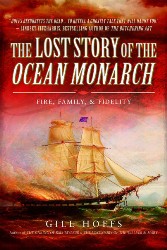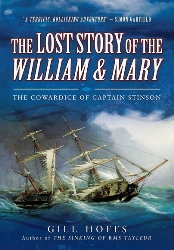 Pirates and Privateers Pirates and Privateers
The History of Maritime
Piracy
Cindy Vallar, Editor
& Reviewer
P.O. Box 425,
Keller, TX 76244-0425
    
Books for Adults ~ Disasters,
Mutinies, & Shipwrecks
The Lost Story of the William &
Mary
The Lost Story
of the Ocean Monarch

The Lost Story of the Ocean
Monarch: Fire,
Family, & Fidelity
by Gill Hoffs
Pen & Sword, 2018,
ISBN 978-1526734397, UK
£19.99 / US $39.95
Also available in other
formats
Water
and fire. Two elements
– one of which will
extinguish the other –
except when the fire
is aboard a wooden
ship and the water is
all around her. Then
you are faced with
little hope for escape
and must decide
whether to drown or
burn to death.
This is the tragedy
nearly 400 men, women,
and children, seventy
of whom are under the
age of fourteen, face
the day they set sail
from Liverpool,
England that fateful
day in August 1848.
Within a few hours,
their ship sinks off
the coast of
Llandudno, Wales.
Ocean Monarch
is bound for Boston
and built by Donald
McKay just the year
before. She has three
decks and is
considered far safer
than the coffin ships
that carry many
immigrants. Life boats
aren’t required,
although a couple are
carried. What
firefighting equipment
she has consists of a
dozen buckets and a
water pump that isn’t
up to snuff. By the
time the fire is
discovered, there is
little anyone can do
and nowhere for most
people to go until
other ships arrive to
help.
Those who board Ocean
Monarch come
from a variety of
backgrounds. Some are
Irish emigrants
seeking a new
homeland. Others are
tourists returning
from their travels. A
handful possess money
and stature. The
majority work for a
living or are
penniless. Nearly half
of them will not
survive. A number of
the passengers are
introduced by name and
followed as events
unfold, such as the
Dows, who are newly
married; Nathaniel
Southworth, a
well-known
miniaturist; James
Fellows, a watchmaker
and jeweler; and
Thomas Henry, who
expressly waits to
sail on this ship
because he knows her
captain. There is also
a man who abandons his
wife to run off with
another man’s wife.
Others are mentioned
for something they do,
such as a stewardess,
whose name is unknown,
who sacrifices her
life to prevent
gunpowder from
exploding which will
have made the tragedy
even worse.
This is more than just
the story of those
aboard the burning
ship. It is also about
her rescuers,
including members of
the Brazilian navy,
exiled French royalty,
and a man who has
rescued people from
another shipwreck. One
of the captains has
even served under
Admiral Lord Horatio
Nelson. Then there are
the pilots and a rumor
of a possible murder.
In twelve chapters,
Hoffs explores events
and people before,
during, and after the
fire. She includes
some black-&-white
photographs, an
epilogue, and personal
note, as well as
appendices that
provide a chronology
of the corpses and
details about them,
locations of grave
sites and inquests,
and a list of medals.
In addition, there is
a list of names of
passengers, stewards,
stewardesses, the
captain and crew, and
some who are aboard
other vessels and come
to the doomed ship’s
aid. A select
bibliography and index
complete the text.
Interspersed
throughout the
narrative are
firsthand accounts and
newspaper reports of
what happened that day
and in the days that
follow.
What becomes clear in
reading this story is
that this travesty
need not have been as
horrific as it ends up
being and that despite
the passing of more
than a century and a
half, there still is
no concrete proof as
to how the fire
starts. In explaining
how she comes to write
this story, Hoffs also
demonstrates the role
social behavior plays
in the events. She
deftly shows the chaos
and confusion that
results from the fire,
and her words paint a
gruesome image of what
the victims endure.
(She does include a
warning note of what
pages to skip for
readers who may be
squeamish.) Rather
than focus on just the
microcosm of the ship,
she elaborates on what
is happening in the
world at the time. She
also leaves readers
with many questions
that are never clearly
answered by the
inquests or
investigators. By the
end of the book, she
does share that her
research enables her
to identify six
nameless victims and
what happens to known
survivors.
Perhaps not as
gripping a tale as
Hoffs’s earlier book,
The Lost Story of
the William
& Mary, nor as
clear-cut as to why Ocean
Monarch is a
“lost” tale, The
Lost Story of the Ocean
Monarch is still an
important contribution
to collections
focusing on shipwrecks
and emigrant stories.
Review
Copyright ©2019
Cindy Vallar


The Lost Story of the William
& Mary: The Cowardice of Captain Stinson
by Gill Hoffs
Pen & Sword, 2016, ISBN 978-1473858240, UK £19.99 /
US $34.95
Also available in other formats
    
In the
years leading up to 1853, successive bad harvests
and epidemics struck Europe. Particularly hard hit
was Ireland, where a potato blight led to mass
starvation and death. Working conditions were
deplorable and the amount earned for doing those
jobs was abysmal. One of the few avenues to offer
some hope for escape was emigration. As an essay in
the 23 October 1852 edition of the Oxford
Chronicle and Reading Gazette explained:
America is
to modern Europe . . . the land of aspirations
and dreams, the country of daring enterprise and
the asylum of misfortune, which receives alike
the exile and the adventurer, the discontented
and the aspiring and promises to all a freer
life and a fresher nature. (1)
Why the United States? It
is too far, and hence more costly, to go to
Australia. Canadian winters are too severe and there
are too many hoops to jump through to get past
customs. On the other hand, the United States seems
more welcoming to newcomers, isn’t so far away, and
doesn’t require as much money. Within the pages of
this book, Hoffs shares the story of one particular
voyage and what happens to those moving to America
to start life anew.
On 23 March 1853, William and Mary left
Liverpool, England bound for America with over 200
Europeans who had managed to accumulate sufficient
funds to pay for their passage. Recently constructed
in Maine and just having completed her first
transoceanic voyage, the three-masted barque was a
merchant ship that could carry up to 512 tons. Once
her cargo was unloaded, she was refitted to carry
passengers on the return trip. Her captain, Timothy
Reirdan Stinson, was thirty-two and married to the
daughter of one of the ship’s owners. Serving under
him was a crew of fourteen. After weighing anchor,
the ship headed for New Orleans where the passengers
would disembark and secure other means of getting to
their final destinations.
Many passengers came from Ireland, but the barque
also carried ninety-one settlers from Friesland in
the Netherlands. Bound for Iowa to establish a new
town, these men, women, and children were led by
Oepke Bonnema, a grain merchant who paid their way
on condition that they work for him. They were
supposed to travel to America on a different ship,
but by the time they reached Liverpool, that
steamship already carried a full complement of
emigrants. Among their group were two people who
would prove invaluable to all the passengers – a
midwife and Johannes van der Veer, a
fifty-six-year-old doctor.
Although the journey began on a beautiful day and
they welcomed a new baby into their midst on the
next, the promising start failed to carry through
the entire voyage. In addition to the crockery
stowed in her hull, William and Mary carried
iron freight that made her roll so badly it wasn’t
safe to be on deck in foul weather. Kept mostly
belowdecks, the passengers endured air and
conditions that were far from healthy; fourteen
died, and their deaths and burials left vivid
impressions on those left behind. Insufficient
provisions meant severe rationing and a meager diet
of hard biscuit, dry rice, and boiled peas. Rats
provided the only meat available to passengers and
crew alike. By later April and early May, conditions
were such that violence simmered just below the
surface, waiting for just the right spark.
Another complication was the barque’s location; she
sailed in shark-infested waters around the low-lying
Bahamas where hidden dangers lurked. During a storm
on 3 May, William and Mary became impaled on
a rock and water began to flow into her hold. With
only five boats on board, none of which had been
used during the voyage, not everyone would escape.
What the passengers did not expect was to see the
captain and most of the crew escape with only a
handful of travelers. The only reason any of the
remaining emigrants survived was because a heroic
wrecker placed a higher value on their lives than on
salvaging the wreckage. Perhaps even more astounding
was that no investigation was conducted and no one
faced any charges or paid any price for what
happened.
Each chapter opens with a quoted passage, from
various sources, that pertain to some relevant
aspect of the journey. The passage of time is also
clearly identified, making it easier to keep track
of what happens when. The first chapter sets the
stage, providing readers with necessary background
to fully grasp the situation. Footnotes are included
where the material is most pertinent, rather than
requiring the reader to look up the marked passage
in endnotes at the back of the book. There is a
center section of black-&-white cartoons,
newspaper illustrations, advertisements, and a map.
One image is the only surviving one of William
and Mary, and several pages of photographs
allow readers to put names to faces. The appendix
includes a list of the passengers, although not all
details about these people are complete. Hoffs does
provide an e-mail address so that anyone who can
provide missing information may contact her. A
bibliography and index are also included.
In the accounts shared, Hoffs keenly shows the
difference in value placed on human life versus that
of livestock. She crafts a heart-wrenching and vivid
tale composed primarily from firsthand accounts that
allows readers to envision the terrifying journey
these people endure. She also shares what happens to
those survivors whom she could track through a
variety of sources including contemporary
newspapers, survivors’ stories, later articles on
the disaster, and family histories. Instead of
simply names on the page, these people come alive.
This book is far more than just the story of this
ship and those on board. Hoffs enriches the story
with accounts from other passages and descriptions
to provide readers with a fuller understanding of
conditions that lead to emigration, what such
journeys are really like, and what occurs in the
aftermath of the accident and the shameful behavior
of those who escape unscathed. In doing so, readers
gain a better appreciation for the dangers their own
ancestors may have faced to make a new life in a new
land.
Review
Copyright ©2017
Cindy Vallar


Click to contact me
Background image compliments
of Anke's Graphics |


